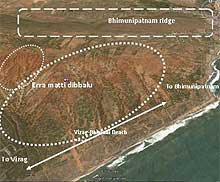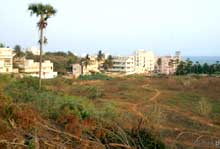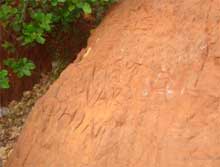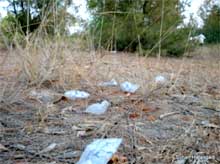|
There have been reports that Andhra Pradesh Tourism Development Corporation (APTDC) plans to put up a tourist facility at "Erra matti dibbalu" ("Red Sand Hills") near Bhimunipatnam. The reports have caused concern among certain sections of the public as well as those from the scientific community. This site is the last remaining area having the unique red sand dune formations which are such a rarity. It is felt that establishing a tourism facility there will deeply impact the pristine nature of the area and seal the fate of this fragile ecological wonder.
Where are the "Erra matti dibbalu "and what is unique about them?
On the Bay of Bengal coast, to the south of the Bhimunipatnam ridge, is an area comprising deeply gullied red sand dunes of around 4 km length and 2 km width. It is bounded by streams "Chittigadda" in the North-West and "Peddagadda" in the South-West. This area is referred to as "Erra matti dibbalu". They are unique because of the gullied red dunes formations. (Fig 1, Pic of "Erra matti dibbalu") (Fig 2, Pic showing location on Google Earth)
|
 |
 |
| Fig 1, Pic of "Erra matti dibbalu" |
Fig 2, Pic showing location on Google Earth |
|
|
How the "Erra matti dibbalu" formed and what gave the sand its unique red colour?
These questions have challenged geologists since more than a century. Some scientists are of the opinion that the initial chapter of this epic story took place in the "Pleistocene" period from around 1.8 million years ago to around 10,000 years ago. During that time the sea level rose to as much as 50 meters above the current level and fell away below the current level many times. Between these oscillating sea levels the coast was submerged and exposed over and over again.
When the sea receded it left behind huge volumes of clay and silt. Subsequently, the beach sand swept over the clay and silt, and over time this "Aeolian" (carried by wind) sand covered the earlier soil forming large sand dunes. The clay and silt under the sand then "baked" in the sun much like a brick gets baked in a kiln leading to the peculiar red earth. Later, action of the wind and flowing water caused the deeply gullied characteristic landscape. The red colour of the dunes is said to be due to the "ferrogination" of "haemitite". This simply means that iron rich material haemitite coated the loose sand grains and when it got exposed to the elements the stuff oxidized over a period of time. Just like a nail exposed to salty air would get corroded and appear red in colour.
By no means is the explanation of the process that caused the red hills definitive. Other theories suggest that the main cause of the formation is mainly due to "Fluvial" meaning action caused by flowing water. And that it happened in a period of tectonic quiescence - a quiet period without too much tectonic activity. Yet others are convinced that much of what we see today is due to the "Neotechtonic" activity, this fancy word simply means tectonic activity that took place in the recent past, which is around 6,000 years ago. Dr. Srinivas Madabhushi points out that the sudden change in the flow of the Gosthani River, the gap in the Bhimunipatnam ridge, the pattern of fractures and several other clues clearly indicate a series of recent tectonic activities.
It is possible that the theories converge at a point to explain the surreal "Erra matti dibbalu" landscape, but the jury is still out on the exact process that caused these formations. That is why it is even more important that these dunes be preserved in its original form for future generations to study and to admire.
"Nowhere else along the Indian coast, the red sand hills are so striking and extensive. There is every need to protect and preserve them for posterity. This area is a "Living Museum and should be preserved…" Dr. Jagannadha Rao, Geology Dept. Andhra University.
Rapid loss of Red Sand Dunes over the last 5 decades
Even as recently as in the 1970s Vizag still had several square miles of this topography near the coast. The area what is now known as Ramakrishna beach and up to Andhra University were full of "Erra matti dibbalu" The changes are clearly visible in the set of photos here which compares the same area in 1985 and the present. (Fig 3 & 4 alongside Pictures comparing same view in 1985 and 2009)
|
 |
 |
| Fig 3 Alongside Picture in 1985 |
Fig 4 Alongside Picture in 2009 |
|
|
The pressure of urbanization and the negligence of this amazing resource have meant that the "Erra matti dibbalu" that was formed over thousands and thousands of years is vanishing in a 50 year blink of history, right before our eyes. Now we are left with just one small island of this formation near Bhimunipatnam and that is also under threat of being destroyed forever.
The threat of unsupervised tourism at "Erra matti dibbalu" Bhimunipatnam
When you read tourist brochures or browse the net for sites to visit in Vizag you will come across a rather casual statement: "Erra matti dibbalu is a picnic spot near Rushikonda, Visakhapatnam - Andhra Pradesh"
"Picnic spot" Every day especially during the cooler season tourists and casual visitors visit "Erra matti dibbalu". It is obvious that the predominant number of visitors to the site do not visit the site to marvel at its beauty or wonder at the geological phenomena that caused the awe inspiring landscape. One teacher who took a bus load of school kids to the site told me that she did not have a clue about what the "Erra matti dibbalu" was - she was simply there for a school picnic. Picnickers bring their food and drink, put loud music and trample all over the sensitive area. They carve their names on the walls of the dibbalu and leave behind ugly garbage. (Fig 5, Pic of Graffiti on dibbalu wall) (Fig 6, Pic of garbage strewn on the ground)
|
 |
 |
| Fig 5, Pic of Graffiti on dibbalu wall |
Fig 6, Pic of garbage strewn on the ground |
|
|
Film shooting: Adding to the woes of the area is the shooting of films in the area. Filming crews descend on the "Erra matti dibbalu" with their equipment, temporary sun shades, generators and catering facility. They leave behind mountains of rubbish that remain on the site. During one movie shooting they even coated the "Erra matti dibbalu" with white lime wash because the movie wanted to show the hillocks as snow covered hills! Such insensitive treatment of a natural treasure has already caused severe damage to the area and action must be taken to stop the further deterioration of the site.
Eco-tourism label: We can expect the tourism department to slap an "Eco-tourism" label on the project and push through with the proposal. The phrase "Eco-tourism" is used to describe tourism projects in environmentally sensitive areas. It is a deceptive term because it lulls us into believing that simply following the set of guidelines everything will be fine.
The fact is that no tourism project can be really safe in an eco-sensitive area unless the project proponents have all the resources to implement such a project and the visitors are mature enough to scrupulously follow the rules that apply to the area. Half measures will simply open the floodgate of "eco-destruction".
The Bora Caves example: The ham handed management of the Bora Caves near Araku Valley by APTDC clearly indicates that they have a lot to learn about managing eco-sensitive sites. The Bora area is full of litter, the road access is crowded with haphazard traffic, and there is litter everywhere. Unsupervised visitors treat the area as an amusement park; they merrily picnic in the area, touch the cave formations and scribble graffiti on them. Some time ago when a tourism minister visited the site, zealous staff spread bleaching powder all over the cave floor! In their constant endeavor to increase visitor traffic to the caves they are accelerate the destruction of the caves.
The guides are poorly trained and do not convey the importance and wonder of the geological formations, instead they list the movies that have been filmed there and point out at how some of the formations resemble one God or the other. The handling of revenue sharing between the tribal stakeholders of the area and the corporation is still not implemented. Despite several appeals and assurances of a reasonable and equitable sharing formula the matter still is in a state of limbo.
In conclusion, while the "Erra matti dibbalu" area near Bhimunipatnam does have the potential to develop as an important tourist destination in the future, but it will require topnotch park management skills and substantial investments which the APTDC does not have at present. Until all the required resources are readily available nothing should be done to jeopardize the ecological integrity of the "Erra matti dibbalu".
|
|





